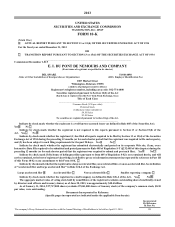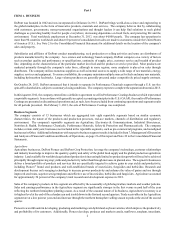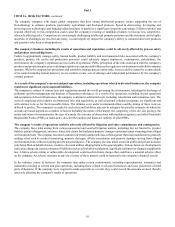DuPont 2013 Annual Report Download - page 11
Download and view the complete annual report
Please find page 11 of the 2013 DuPont annual report below. You can navigate through the pages in the report by either clicking on the pages listed below, or by using the keyword search tool below to find specific information within the annual report.Part I
ITEM 1A. RISK FACTORS, continued
10
The company competes with major global companies that have strong intellectual property estates supporting the use of
biotechnology to enhance products, particularly agricultural and bio-based products. Speed in discovering, developing and
protecting new technologies and bringing related products to market is a significant competitive advantage. Failure to predict and
respond effectively to this competition could cause the company's existing or candidate products to become less competitive,
adversely affecting sales. Competitors are increasingly challenging intellectual property positions and the outcomes can be highly
uncertain. If challenges are resolved adversely, it could negatively impact the company's ability to commercialize new products
and generate sales from existing products.
The company's business, including its results of operations and reputation, could be adversely affected by process safety
and product stewardship issues.
Failure to appropriately manage safety, human health, product liability and environmental risks associated with the company's
products, product life cycles and production processes could adversely impact employees, communities, stakeholders, the
environment, the company's reputation and its results of operations. Public perception of the risks associated with the company's
products and production processes could impact product acceptance and influence the regulatory environment in which the company
operates. While the company has procedures and controls to manage process safety risks, issues could be created by events outside
of its control including natural disasters, severe weather events, acts of sabotage and substandard performance by the company's
external partners.
As a result of the company's current and past operations, including operations related to divested businesses, the company
could incur significant environmental liabilities.
The company is subject to various laws and regulations around the world governing the environment, including the discharge of
pollutants and the management and disposal of hazardous substances. As a result of its operations, including its past operations
and operations of divested businesses, the company could incur substantial costs, including remediation and restoration costs. The
costs of complying with complex environmental laws and regulations, as well as internal voluntary programs, are significant and
will continue to be so for the foreseeable future. The ultimate costs under environmental laws and the timing of these costs are
difficult to predict. The company's accruals for such costs and liabilities may not be adequate because the estimates on which the
accruals are based depend on a number of factors including the nature of the matter, the complexity of the site, site geology, the
nature and extent of contamination, the type of remedy, the outcome of discussions with regulatory agencies and other Potentially
Responsible Parties (PRPs) at multi-party sites and the number and financial viability of other PRPs.
The company's results of operations could be adversely affected by litigation and other commitments and contingencies.
The company faces risks arising from various unasserted and asserted litigation matters, including, but not limited to, product
liability, patent infringement, antitrust claims, and claims for third party property damage or personal injury stemming from alleged
environmental torts. The company has noted a nationwide trend in purported class actions against chemical manufacturers generally
seeking relief such as medical monitoring, property damages, off-site remediation and punitive damages arising from alleged
environmental torts without claiming present personal injuries. The company also has noted a trend in public and private nuisance
suits being filed on behalf of states, counties, cities and utilities alleging harm to the general public. Various factors or developments
can lead to changes in current estimates of liabilities such as a final adverse judgment, significant settlement or changes in applicable
law. A future adverse ruling or unfavorable development could result in future charges that could have a material adverse effect
on the company. An adverse outcome in any one or more of these matters could be material to the company's financial results.
In the ordinary course of business, the company may make certain commitments, including representations, warranties and
indemnities relating to current and past operations, including those related to divested businesses and issue guarantees of third
party obligations. If the company were required to make payments as a result, they could exceed the amounts accrued, thereby
adversely affecting the company's results of operations.
























